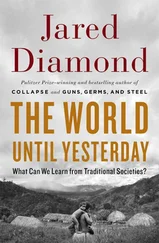Jared Diamond - Guns, Germs & Steel
Здесь есть возможность читать онлайн «Jared Diamond - Guns, Germs & Steel» весь текст электронной книги совершенно бесплатно (целиком полную версию без сокращений). В некоторых случаях можно слушать аудио, скачать через торрент в формате fb2 и присутствует краткое содержание. Жанр: 105. Описание произведения, (предисловие) а так же отзывы посетителей доступны на портале библиотеки ЛибКат.
- Название:Guns, Germs & Steel
- Автор:
- Жанр:
- Год:неизвестен
- ISBN:нет данных
- Рейтинг книги:5 / 5. Голосов: 1
-
Избранное:Добавить в избранное
- Отзывы:
-
Ваша оценка:
- 100
- 1
- 2
- 3
- 4
- 5
Guns, Germs & Steel: краткое содержание, описание и аннотация
Предлагаем к чтению аннотацию, описание, краткое содержание или предисловие (зависит от того, что написал сам автор книги «Guns, Germs & Steel»). Если вы не нашли необходимую информацию о книге — напишите в комментариях, мы постараемся отыскать её.
Guns, Germs & Steel — читать онлайн бесплатно полную книгу (весь текст) целиком
Ниже представлен текст книги, разбитый по страницам. Система сохранения места последней прочитанной страницы, позволяет с удобством читать онлайн бесплатно книгу «Guns, Germs & Steel», без необходимости каждый раз заново искать на чём Вы остановились. Поставьте закладку, и сможете в любой момент перейти на страницу, на которой закончили чтение.
Интервал:
Закладка:
I 8 O • GUNS, GERMS, AND STEEL
more subtle evidence that crops spread more easily out of Southwest Asia than in the Americas.
Rapid spread of a crop may preempt domestication not only of the same wild ancestral species somewhere else but also of related wild species. If you're already growing good peas, it's of course pointless to start from scratch to domesticate the same wild ancestral pea again, but it's also pointless to domesticate closely related wild pea species that for farmers are virtually equivalent to the already domesticated pea species. All of Southwest Asia's founder crops preempted domestication of any of their close relatives throughout the whole expanse of western Eurasia. In contrast, the New World presents many cases of equivalent and closely related, but nevertheless distinct, species having been domesticated in Meso-america and South America. For instance, 95 percent of the cotton grown in the world today belongs to the cotton species Gossypium hirsutum, which was domesticated in prehistoric times in Mesoamerica. However, prehistoric South American farmers instead grew the related cotton Gos sypium barbadense. Evidently, Mesoamerican cotton had such difficulty reaching South America that it failed in the prehistoric era to preempt the domestication of a different cotton species there (and vice versa). Chili peppers, squashes, amaranths, and chenopods are other crops of which different but related species were domesticated in Mesoamerica and South America, since no species was able to spread fast enough to preempt the others.
We thus have many different phenomena converging on the same conclusion: that food production spread more readily out of Southwest Asia than in the Americas, and possibly also than in sub-Saharan Africa. Those phenomena include food production's complete failure to reach some ecologically suitable areas; the differences in its rate and selectivity of spread; and the differences in whether the earliest domesticated crops preempted redomestications of the same species or domestications of close relatives. What was it about the Americas and Africa that made the spread of food production more difficult there than in Eurasia?
To answer this question, let's begin by examining the rapid spread of food production out of Southwest Asia (the Fertile Crescent). Soon after food production arose there, somewhat before 8000 b.c., a centrifugal wave of it appeared in other parts of western Eurasia and North Africa
SPACIOUS SKIES AND TILTED AXES • I 8 I
farther and farther removed from the Fertile Crescent, to the west and east. On this page I have redrawn the striking map (Figure 10.2) assembled by the geneticist Daniel Zohary and botanist Maria Hopf, in which they illustrate how the wave had reached Greece and Cyprus and the Indian subcontinent by 6500 b.c., Egypt soon after 6000 b.c., central Europe by 5400 b.c., southern Spain by 5200 b.c., and Britain around 3500 b.c. In each of those areas, food production was initiated by some of the same suite of domestic plants and animals that launched it in the Fertile Crescent. In addition, the Fertile Crescent package penetrated Africa southward to Ethiopia at some still-uncertain date. However, Ethiopia also developed many indigenous crops, and we do not yet know whether it was these crops or the arriving Fertile Crescent crops that launched Ethiopian food production.
The spread of Fertile Crescent crops across western Eurasia
o before 7000 bc
• 7000-6000 bc
O 6000-5000 BC
5000-3800 bc
3800-2500 BC
Figure 10.2. The symbols show early radiocarbon-dated sites where remains of Fertile Crescent crops have been found. D = the Fertile Crescent itself (sites before 7000 b.c.). Note that dates become progressively later as one gets farther from the Fertile Crescent. This map is based on Map 20 of Zohary and Hopf's Domestication of Plants in the Old World but substitutes calibrated radiocarbon dates for their uncalibrated dates.
I 8 2. • GUNS, GERMS, ANDsteel
Of course, not all pieces of the package spread* to all those outlying areas: for example, Egypt was too warm for einkorn wheat to become established. In some outlying areas, elements of the package arrived at different times: for instance, sheep preceded cereals in southwestern Europe. Some outlying areas went on to domesticate a few local crops of their own, such as poppies in western Europe and watermelons possibly in Egypt. But most food production in outlying areas depended initially on Fertile Crescent domesticates. Their spread was soon followed by that of other innovations originating in or near the Fertile Crescent, including the wheel, writing, metalworking techniques, milking, fruit trees, and beet and wine production.
Why did the same plant package launch food production throughout western Eurasia? Was it because the same set of plants occurred in the wild in many areas, were found useful there just as in the Fertile Crescent, and were independently domesticated? No, that's not the reason. First, many of the Fertile Crescent's founder crops don't even occur in the wild outside Southwest Asia. For instance, none of the eight main founder crops except-barley grows wild in Egypt. Egypt's Nile Valley provides an environment similar to the Fertile Crescent's Tigris and Euphrates Valleys. Hence the$ package that worked well in the latter valleys also worked well enough in the Nile Valley to trigger the spectacular rise of indigenous Egyptian civilization. But the foods to fuel that spectacular rise were originally absent in Egypt. The sphinx and pyramids were built by people fed on crops originally native to the Fertile Crescent, not to Egypt.
Second, even for those crops whose wild ancestor does occur outside of Southwest Asia, we can be confident that the crops of Europe and India were mostly obtained from Southwest Asia and were not local domesticates. For example, wild flax occurs west to Britain and Algeria and east to the Caspian Sea, while wild barley occurs east even to Tibet. However, for most of the Fertile Crescent's founding crops, all cultivated varieties in the world today share only one arrangement of chromosomes out of the multiple arrangements found in the wild ancestor; or else they share only a single mutation (out of many possible mutations) by which the cultivated varieties differ from the wild ancestor in characteristics desirable TO humans. For instance, all cultivated peas share the same recessive gene that prevents ripe pods of cultivated peas from spontaneously popping ope* and spilling their peas, as wild pea pods do.
Evidently, most of the Fertile Crescent's founder crops were never
SPACIOUS SKIES AND TILTED AXES • 183
domesticated again elsewhere after their initial domestication in the Fertile Crescent. Had they been repeatedly domesticated independently, they would exhibit legacies of those multiple origins in the form of varied chromosomal arrangements or varied mutations. Hence these are typical examples of the phenomenon of preemptive domestication that we discussed above. The quick spread of the Fertile Crescent package preempted any possible other attempts, within the Fertile Crescent or elsewhere, to domesticate the same wild ancestors. Once the crop had become available, there was no further need to gather it from the wild and thereby set it on the path to domestication again.
The ancestors of most of the founder crops have wild relatives, in the Fertile Crescent and elsewhere, that would also have been suitable for domestication. For example, peas belong to the genus Pisum, which consists of two wild species: Pisum sativum, the one that became domesticated to yield our garden peas, and Pisum fulvum, which was never domesticated. Yet wild peas of Pisum fulvum taste good, either fresh or dried, and are common in the wild. Similarly, wheats, barley, lentil, chickpea, beans, and flax all have numerous wild relatives besides the ones that became domesticated. Some of those related beans and barleys were indeed domesticated independently in the Americas or China, far from the early site of domestication in the Fertile Crescent. But in western Eurasia only one of several potentially useful wild species was domesticated—probably because that one spread so quickly that people soon stopped gathering the other wild relatives and ate only the crop. Again as we discussed above, the crop's rapid spread preempted any possible further attempts to domesticate its relatives, as well as to redomesticate its ancestor.
why was the spread of crops from the Fertile Crescent so rapid? The answer depends partly on that east-west axis of Eurasia with which I opened this chapter. Localities distributed east and west of each other at the same latitude share exactly the same day length and its seasonal variations. To a lesser degree, they also tend to share similar diseases, regimes of temperature and rainfall, and habitats or biomes (types of vegetation). For example, southern Italy, northern Iran, and Japan, all located at about the same latitude but lying successively 4,000 miles east or west of each other, are more similar to each other in climate than each is to a location lying even a mere 1,000 miles due south. On all the continents the habitat
Интервал:
Закладка:
Похожие книги на «Guns, Germs & Steel»
Представляем Вашему вниманию похожие книги на «Guns, Germs & Steel» списком для выбора. Мы отобрали схожую по названию и смыслу литературу в надежде предоставить читателям больше вариантов отыскать новые, интересные, ещё непрочитанные произведения.
Обсуждение, отзывы о книге «Guns, Germs & Steel» и просто собственные мнения читателей. Оставьте ваши комментарии, напишите, что Вы думаете о произведении, его смысле или главных героях. Укажите что конкретно понравилось, а что нет, и почему Вы так считаете.










